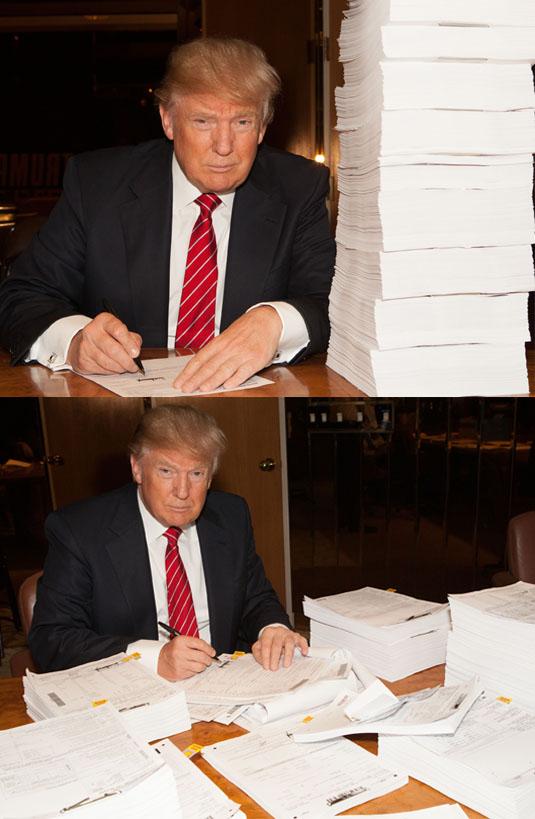Income Tax
New Study Pokes Holes in Trump’s Tax Plan
Calls for federal income tax cuts are a time-honored tradition by presidential candidates of all stripes, but the Tax Policy Center study says that Trump’s plan dwarfs the proposals made by other GOP contenders.
Dec. 28, 2015

According to an analysis by the Tax Policy Center, the tax plan pitched in September by billionaire Donald Trump, the current front runner for the Republican presidential nomination, would boost after-tax income of the most wealthy individuals (those with over $3.7 million in annual income) by more than $1.3 million a year while lowering the amount the government can collect by $9.5 trillion in tax revenue over the next decade. The Tax Policy Center is an independent and purportedly nonpartisan group functioning as part of the Washington D.C.-based Urban Institute and Brookings Institution.
Calls for federal income tax cuts are a time-honored tradition by presidential candidates of all stripes, but the Tax Policy Center study says that Trump’s plan dwarfs the proposals made by other GOP contenders. In comparison, its recent analysis of the changes posed by Jeb Bush, former governor of Florida, estimated a $6.8 trillion reduction in tax revenue to the government over the same period. The Tax Policy Center report doesn’t address proposed cuts and changes in government spending that would need to be implemented in order to offset the reduction in government revenue.
The centerpiece of Trump’s tax plan is a reduction of the current seven-bracket structure into just three tax brackets of 10 percent, 20 percent and 25 percent. Currently, the top tax bracket of 39.6 percent is almost 15 percent higher than the top rate proposed by Trump. The first $25,000 of income earned by an individual, or $50,000 by a married couple, would be completely exempt from tax. The expectation is that this program would provide unprecedented incentives for average Americans to work, save, and invest.
In addition, Trump has proposed a cut in the top corporate tax rate from 35 percent to 15 percent, less than half the current rate. He would also curb certain itemized deductions (other than deductions for charitable contributions and mortgage interest), repeal the alternative minimum tax (AMT), and treat tax carried interest as ordinary business income. Trump has characterized investment managers as “getting away with murder” due to the current rule of taxing carried interest as favorably-taxed capital gain. Finally, Trump would eliminate federal estate and gift taxes.
Overall, the Tax Policy Center says the plan would cut taxes by an average of about $5,100, or about 7 percent of after-tax income. But the highest-income 0.1 percent of taxpayers (those who have incomes of more than $3.7 million in 2015 dollars) would experience an average tax cut of more than $1.3 million in 2017, nearly 19 percent of after-tax income. Middle-income households would receive an average tax cut of $2,700, or 4.9 percent of after-tax income.
For lower-income individuals, the plan would exempt another 33 million households from tax. The study found that 63 percent of households would pay zero federal income tax in 2017 as opposed to the current figure of 44 percent. Overall, the plan would result in a massive simplification of the tax code, primarily due to the increased standard deductions. An estimated 86 percent of current itemizers would receive greater tax benefit by using the standard deduction than the benefit they would have received in previous years by itemizing.
Trump has stated that super-rich people like himself would be the ones hit hardest by his proposed tax plan, but the Tax Policy Center disagrees. “Donald Trump hasn’t released his tax returns, but people in his income group would get huge tax cuts,” Len Burman, director of the Tax Policy Center, told reporters when the study was released on December 22. “The revenue losses from this plan are really enormous,” he later added.
The Tax Policy Center has been accused of liberal leanings, but the Tax Foundation, a conservative think tank, has previously estimated that Trump’s plan would cut taxes by $11.98 trillion over the next decade while reducing tax revenue to the government by $10.14 trillion. It’s clear that the plan would certainly make a sizeable dent in the government’s coffers.
The other presidential candidates in this election year won’t be able to escape the microscope either. The Tax Policy Centers says it will be reviewing and publishing studies on the tax proposals of GOP candidates Marco Rubio and Ted Cruz, as well as the leading Democratic candidate Hillary Clinton and her main challenger, Bernie Sanders. Expect the rhetoric to fly fast and furious as the campaign heads down the stretch.
